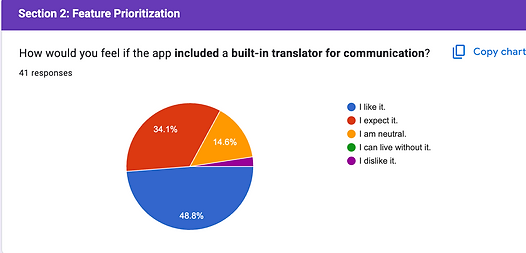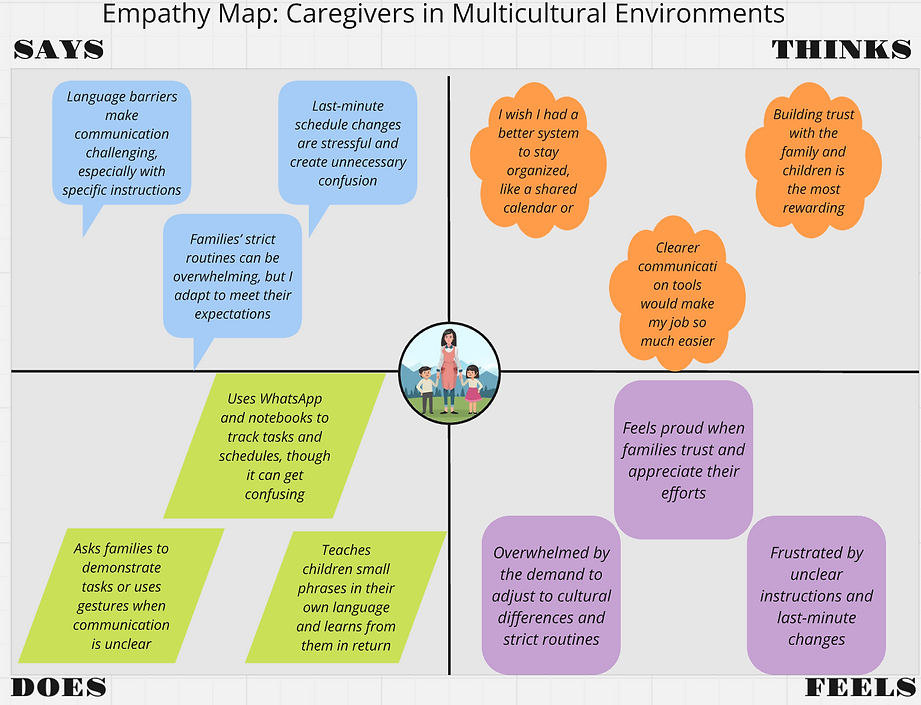
Parenting Across Cultures: UX Insights for Seamless Childcare Solutions
Project Overview
Raising children in multicultural contexts presents families with a unique blend of opportunities and challenges.
Navigating diverse cultural expectations, overcoming language differences, and coordinating caregiving responsibilities often require tailored solutions that existing tools do not fully address.
This research set out to explore the unique challenges faced by multicultural families, with a focus on understanding their needs and experiences. By analyzing these challenges and identifying gaps in existing digital solutions, the study informed the design of an innovative app. The resulting app aims to simplify childcare routines while honoring and celebrating cultural heritage.
Research Focus
This research sought to understand the challenges faced by multicultural families and caregivers, aiming to inform the design of a digital solution that streamline childcare operations while honoring cultural heritage. To achieve this, the study:
-
Explored the needs and challenges of parents and caregivers in diverse cultural contexts.
-
Identified gaps in existing digital tools to guide innovative app design.
-
Identified and prioritized design features for a digital tool that addresses the practical and cultural needs of these families, guided by user insights and research findings.
_edited.jpg)
Key research questions guiding the study on multicultural parenting
Path to Insights: The Research Approach
.jpg)
1️⃣ Target Audience Identification
-
Primary Users: Engaged families raising children in cultural contexts different from the ones they grew up in, navigating new cultural
-
Secondary Users: Included local childcare providers adapting to the diverse parenting practices and cultural contexts of the multicultural families they work with.
Structured research process for the UX study
2️⃣ Sampling Strategy
-
Purposive Sampling: Selected participants with firsthand experience navigating multicultural childcare challenges.
-
Snowball Sampling: Leveraged participant networks to expand the reach and diversify caregiver and family perspectives.
.jpg)
Overview of research participants and demographics

Affinity map highlighting key themes from user research
3️⃣ Interview Analysis
-
Thematic Analysis: Systematically reviewed and coded interview responses to identify recurring themes and sub-themes, highlighting user needs and challenges.
-
Affinity Mapping: Organized insights into distinct categories, visually representing relationships and patterns.
-
Direct Quotes Integration: Incorporated meaningful participant quotes to authenticate findings and provide user-centered perspectives.
-
Iterative Refinement: Adjusted and refined categories to capture the nuanced experiences of diverse participants.
4️⃣ Survey Analysis
-
Response Trends: Analyzed 41 participant responses to uncover key user preferences, challenges, and feature priorities.
-
Feature Evaluation: Prioritized app features using the Kano model, highlighting which functionalities users valued most for the MVP.
-
Data Integration: Combined survey findings with interview insights to ensure a well-rounded understanding of user needs.

Survey results on user preference for a built-in translator
Key Insights: Understanding Multicultural Parenting and Caregiving Challenges
Based on the in-depth interviews with multicultural parents and caregivers, this research uncovered the unique challenges and nuanced needs of these groups as they navigate cross-cultural environments. The findings highlight overlapping struggles, distinctive motivations, and actionable opportunities for improving their experiences.
🔶 Empathy Maps

Empathy map illustrating challenges and behaviors of multicultural parents
The parents often faced a delicate balancing act between adapting to local customs and preserving their cultural heritage. Language barriers emerge as a recurring challenge, particularly when navigating communications with their household staff, accessing local resources, or integrating into communities. They expressed frustration at the limited tools available to bridge these gaps and the time spent researching solutions.
Key takeaways include:
🚀 Language Challenges: Parents struggle to interact with locals and household staff and decipher event notices due to language differences, often relying on translation apps with mixed results.
🚀 Cultural Preservation: Parents worry about their children losing connection with their cultural roots and actively use food, traditions, and language at home to counter this.
🚀 Emotional Well-being: Isolation from familiar cultural networks and difficulties in building new communities amplify the emotional strain of parenting abroad.
🚀 Eco-Friendly Resources: Parents expressed a desire for directories to locate thrift shops or second-hand stores where they could purchase used children’s toys, clothes, and eco-conscious products. These resources aligned with their values of sustainability and affordability.
Despite these challenges, parents prioritized maintaining their children’s sense of identity while adapting to the demands of their new environment. Solutions such as a shared calendar for coordinating family schedules, translation tools to bridge language gaps, and platforms to connect with similar families could offer significant relief and enhance their overall experience. While not explicitly captured in the empathy map, the affinity mapping process highlighted parents’ desire for eco-friendly resources, such as directories for thrift shops and second-hand stores. This finding underscores their value of sustainability and affordability, adding depth to their broader needs.

Empathy map representing experiences of caregivers in multicultural settings
While parents navigate the complexities of adapting to new cultural contexts, caregivers, including nannies, housekeepers, and drivers, face their own set of challenges. They shoulder the responsibility of meeting diverse cultural expectations while providing exceptional care, often within the context of families striving to preserve their heritage. Communication barriers, differing cultural norms, and the need to build trust highlight the intricate dynamics between parents and household staff.
Key insights include:
🚀 Communication Barriers: Caregivers often rely on translation apps, gestures, or demonstrations to overcome language gaps, which can result in misinterpretations of tasks or expectations. This mirrors the parents’ own struggles with language, creating a shared need for more effective tools.
🚀 Cultural Sensitivity: Adjusting to differences in parenting styles, meal preparation, and household organization is a recurring challenge but also a valuable opportunity for mutual learning and growth.
🚀 Relationship Building: Caregivers deeply value trust and appreciation from the families they work with. They find the strongest rewards in the bonds they form with children and the recognition of their contributions.
Overall, caregivers also aspire to tools like, translators, shared calendars and cultural guides to better understand family preferences and manage their tasks seamlessly. Such innovations would not only reduce stress and misunderstandings but also foster stronger partnerships between families and their household staff. These tools, combined with the solutions identified for parents, could significantly enhance the overall experience for multicultural families and caregivers alike.
🔶 Competitor Analysis
Building on the findings from multicultural families and caregivers, I conducted a competitor analysis to identify market gaps and opportunities for the proposed Multicultural Childcare App. This analysis highlights how existing apps address user needs—and where they fall short—to inform strategic recommendations.
.jpg)
The SWOT matrix highlights key strengths and weaknesses of competitors, alongside opportunities and threats that the proposed Multicultural Childcare App can address.
SWOT analysis of competitor apps in childcare and language learning
Expanding upon the SWOT analysis, this comparison table emphasizes specific gaps in competitor offerings and how the proposed app differentiates itself through unique, user-centered features.

Feature comparison of childcare and language-learning apps
🔶 Strategic Recommendations
Synthesizing the insights from user research and competitor analysis, the following features are recommended for the Multicultural Childcare App:
🚀 Translation Feature: Enable seamless real-time communication between parents and caregivers to overcome language barriers.
🚀 Cultural Preservation Tools: Provide resources like recipes, language lessons, and traditions to help families preserve their cultural heritage.
🚀 Shared Calendar and Task Management: Simplify scheduling and task coordination across parents and caregivers.
🚀 Caregiver-Family Collaboration Tools: Build trust and improve workflows with caregiver-specific tools for task management and communication.
🚀 Eco-Conscious Directories: Include directories for thrift shops and second-hand stores, addressing the desire for sustainable practices.
This synthesis ensures the app not only addresses critical user pain points but also differentiates itself in a competitive market by focusing on multicultural and family-specific needs.
Bringing Insights to life: Personas & Prioritized Features
Building on the research findings and recommended features, two personas were crafted to illustrate the core challenges, goals, and needs of the app’s primary users: multicultural parents and caregivers. These personas serve as a guiding framework to ensure that the app’s features align with user needs and address their most pressing pain points.
🔶 Personas: Multicultural Parent & Multicultural Caregiver
.jpg)
The Multicultural Parent Persona (represented by Amina, shown above) reflects individuals striving to balance their children’s cultural heritage while navigating the demands of adapting to a new environment. Their challenges include managing communication barriers, maintaining cultural traditions, and finding sustainable resources that align with their values.

On the other hand, the Multicultural Caregiver Persona (represented by Sofia, shown above) represents caregivers supporting foreign families, often facing language gaps, unfamiliar routines, and the need to understand diverse cultural practices. Together, these personas capture the complementary yet distinct needs of the app’s primary user group
🔶 Feature Prioritization Metrics: Informed by the Kano Method
To determine which features would deliver the highest value, a survey was conducted using the Kano Model. The responses were analyzed to identify which features would be prioritized in the Minimum Viable Product (MVP).
While all recommended features will be included in the initial app to create a comprehensive solution, the prioritization metrics provides clarity on development sequencing and resource allocation. This ensures that critical features like the Translation Feature receive the most attention during development, while lower-priority features such as Eco-Conscious Directories are implemented with simpler functionalities that can be iteratively enhanced in future updates.
.jpg)
In conclusion, these prioritized features underscore the app's commitment to delivering practical solutions to the core challenges faced by multicultural parents and caregivers. By addressing critical pain points and incorporating user-centered design principles, this app offers a competitive, impactful, and innovative product tailored to real-world needs. This approach not only empowers families and caregivers but also sets a strong foundation for meaningful cultural connection and collaboration in diverse communities.
Intended Impact
The Multicultural Childcare App is projected to achieve a 30%adoption rate within its first year, based on survey findings that revealed 85% of respondents identified translation tools as a critical feature and 78% prioritized shared scheduling tools.
To further emphasize its intended impact, a participant shared:

My Learnings
🔶 Refining Through Piloting: Piloting the survey helped me identify and revise confusing questions, ensuring more accurate and actionable responses.
🔶 Prioritization with Purpose: The Kano Method clarified the distinction between essential and aspirational features, emphasizing solutions to critical user pain points like communication and scheduling.
These insights enhanced the research process and strengthened the alignment between user needs and app design.
User persona of Amina, a multicultural parent balancing work and childcare
User persona of Sophia, a caregiver supporting multicultural families
Feature prioritization based on user needs and impact
User feedback highlighting the importance of a tailored childcare app